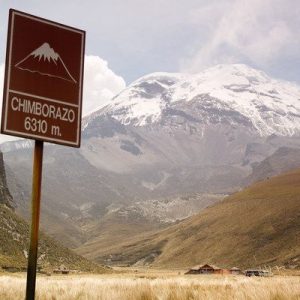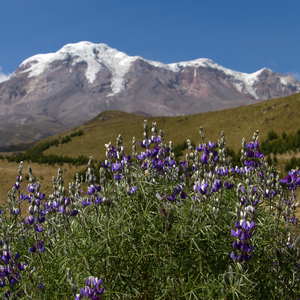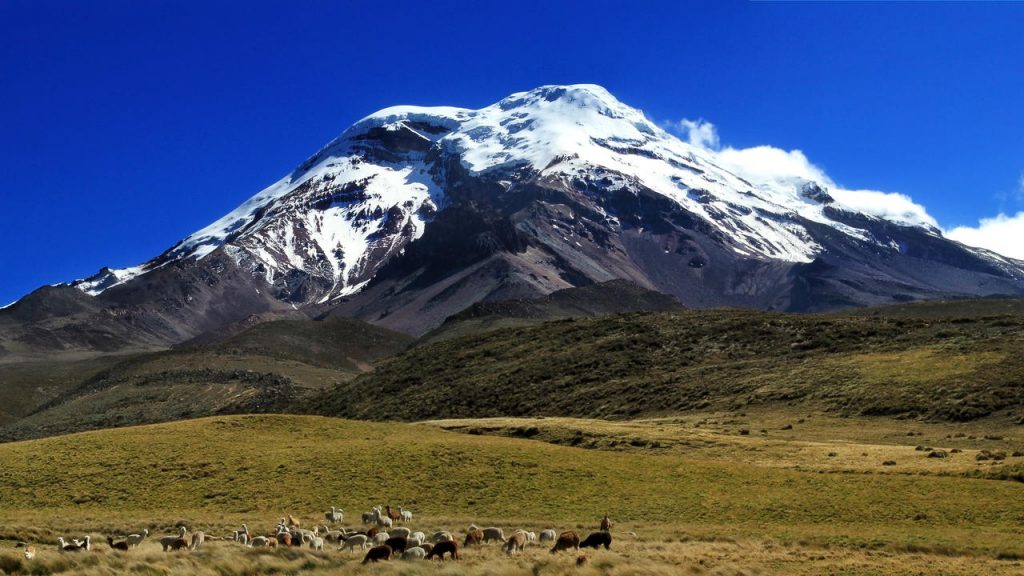Chimborazo
The farthest point from the center of Earth.
El Chimborazo is the highest mountain in Ecuador and due to the flattening of the earth in the polar ice caps, the summit is the farthest point to space from the center of Earth. Taking the center of the earth as a point of reference, the Chimborazo surpasses Mount Everest by two kilometers.
 The inactive volcano is the dream of many mountaineers. El Chimborazo is located 150 km southwest of Quito and 20 km northwest of the city of Riobamba. The volcano is inside the Chimborazo Wildlife Reserve. It is the habitat of the native camel species of the Andes such as the vicuña, llama, and alpaca. The summit of Chimborazo can usually be reached in 2 days. The trip lasts approximately 12 hours (9 hours of ascent and 3 hours of descent). However, we recommend that you carry out an acclimatization process before climbing Chimborazo volcano.
The inactive volcano is the dream of many mountaineers. El Chimborazo is located 150 km southwest of Quito and 20 km northwest of the city of Riobamba. The volcano is inside the Chimborazo Wildlife Reserve. It is the habitat of the native camel species of the Andes such as the vicuña, llama, and alpaca. The summit of Chimborazo can usually be reached in 2 days. The trip lasts approximately 12 hours (9 hours of ascent and 3 hours of descent). However, we recommend that you carry out an acclimatization process before climbing Chimborazo volcano.
Chimborazo
Mountain tour
HIGH: 6.267 m
TYPE: Stratovulkan
CHARACTERISTIC: Inactive volcano
DIFFICULTY LEVEL: BW-4
Day 1: Mountain refuge Hermanos Carrel (4,850 m)
 We will meet at 11 o’clock in Riobamba (the meeting point will be announced in the mandatory registration). We strongly recommend that you have a very good breakfast. First, we go to the Hermanos Carell refuge/shelter, which is located at 4,850 m. Once at the shelter, you will have free time, and you can walk a little for the surroundings of the shelter or reserve your energy for the climb to the Chimborazo´s summit. Them, after a fortifying dinner, you will go to sleep at 18:30 in the afternoon. Finally, you will start climbing to the summit of the Chimborazo volcano at 10:00 at night.
We will meet at 11 o’clock in Riobamba (the meeting point will be announced in the mandatory registration). We strongly recommend that you have a very good breakfast. First, we go to the Hermanos Carell refuge/shelter, which is located at 4,850 m. Once at the shelter, you will have free time, and you can walk a little for the surroundings of the shelter or reserve your energy for the climb to the Chimborazo´s summit. Them, after a fortifying dinner, you will go to sleep at 18:30 in the afternoon. Finally, you will start climbing to the summit of the Chimborazo volcano at 10:00 at night.
Day 2: Summit (6,276 m)
After breakfast, the challenge begins to climb the highest peak in Ecuador. After about an hour we reach the ridge, which leads to the rock “El Castillo” (5,200 m). The ascent is approached through the longest but safest route. And after about 8 hours you will reach the highest point of Ecuador, the top of the Chimborazo volcano called Veintimilla (6,267 m). If the weather conditions are good, the participants still have strength, and time is still enough, you can reach the main summit called Whymper (6.276 m), which is slightly higher in about another hour. The descent takes place on the same route in about 5 hours and, once again, requires a total concentration.
Included
Not Included
Recommended equipment (not included)
BW-1 (gentle walk)
The simplest form of hiking uses only wide and well-developed roads. Mainly on flat terrain and little inclined, without descents and exposed stairs. Usually well marked trails. No special equipment is required, it is recommended to wear comfortable walking shoes. More comfort and less physical activity. Cultural walks with contact with people. No prior knowledge required.
BW-2 (challenging walks / activities)
Activities partially challenging or longer than BW-1 (hiking and cycling). Partially difficult terrain (very steep terrain). Good health and good physical condition are required. Availability to light physical efforts, such as cycling and hiking.
BW-3 (mountains tours / outdoors activities)
Activities or hikes that are often demanding and / or extensive. Trails with considerable slopes, narrow, and not always well marked. For mountaineering an acclimatization process is required (heights more than 4.000 m). Safety when walking. Predisposition for heights. It requires very good health and good physical condition. Adventurous spirit.
BW-4 (Heavy Mountain Tour / outdoors activities)
In this category, mountaineering begins on a high alpine landscape (heights more than 5,000 m). For mountaineering, an acclimatization process is required. Use of crampons, ice axes, harnesses, and helmets are required. It requires excellent general health and physical condition. A sporting spirit and predisposition for demanding weather conditions.
BW-5 (extremely heavy mountain tour / outdoors activities)
Very serious mountain tours that demand a high level of risk-taking even for experienced mountaineers. Routes over very steep, and very exposed rock. As a rule, these alpine excursions are unmarked. The knowledge of the use of the equipment is extremely important. Technical mountains are climbed on this type of tour.
Our active trips are generally not suitable for people with reduced mobility. Do not hesitate to contact us, we will be glad to advise you.
Booking Request
[contact-form-7 id=”2308″ title=”Inquiry Chimborazo_en”]
Ask for this offer or contact us for further details and queries. Of course, we can tailor your dream trip to your individual needs.
Please fill out the form, with your information, the planned travel date and the number of participants. Of course we also advise you by phone or directly by email at the following contact options:









